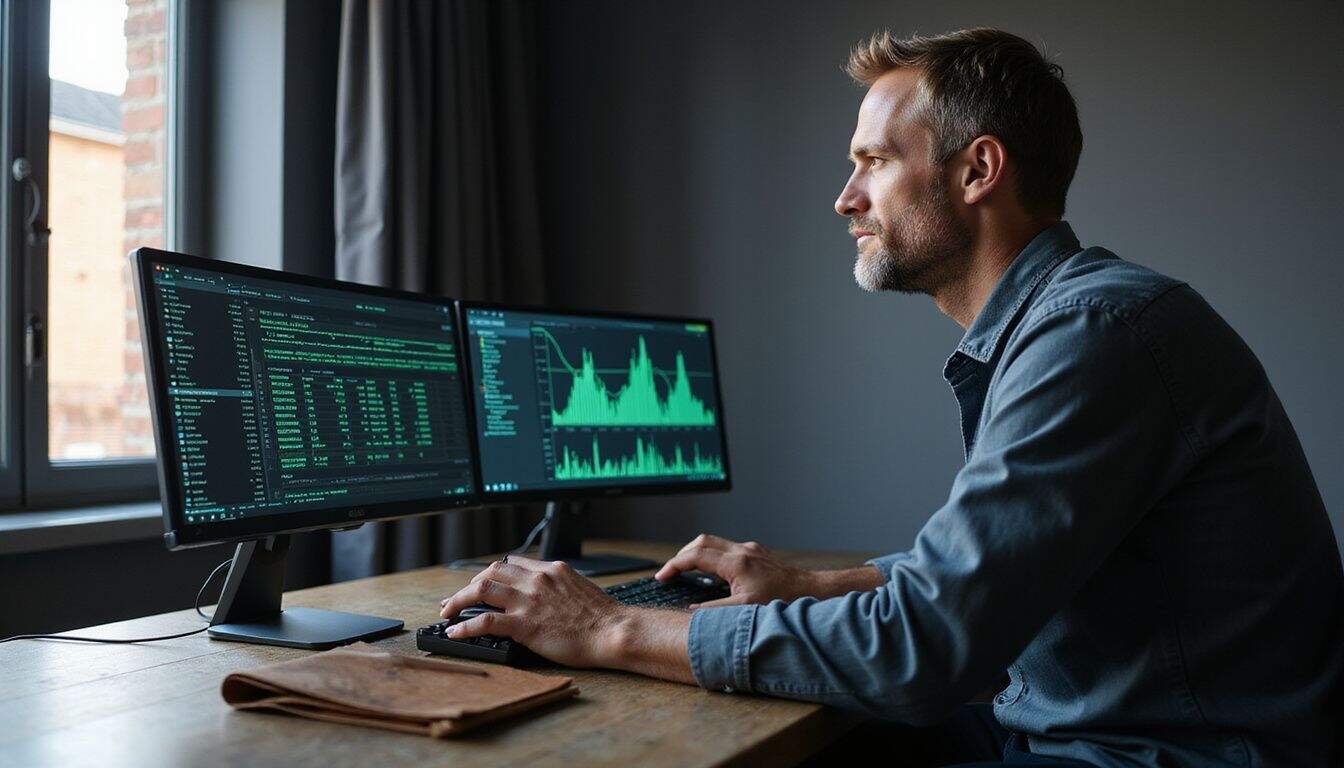Tired of watching crypto markets all day, trying to make smart trades on your own? Crypto AI trading bots use machine learning and advanced algorithms to trade without needing constant oversight.
This guide will clearly explain how to get AI to trade crypto in 7 simple steps—from coding and testing your bot, to deploying it safely online. Read on for stress-free tips that help boost your trading results!
Key Takeaways
AI crypto bots can trade faster and more often than humans, using machine learning and advanced algorithms. Popular platforms include 3Commas, Cryptohopper, Shrimpy, Coinrule (250 ready-made rules), Pionex (16 free built-in bots), TradeSanta ($18-$45/month) and Bitsgap ($22-$111/month).
Building your own AI bot involves choosing languages like Python or JavaScript; defining clear trading goals such as steady profits or quick scalps; testing strategies with historical market data (for example, price swings in December 2017 or May 2021); then deploying securely on cloud servers from providers like Google Cloud or AWS.
Crypto markets move fast—Bitcoin dropped sharply from around $64k in April 2021 to nearly $30k by July the same year. While automated systems help manage trades quickly, sudden volatility poses serious risk that even smart algorithms can’t predict fully.
Effective security is critical to protect your AI-driven crypto bot from hackers. Always enable safety measures including two-factor authentication (2FA) when connecting APIs between exchanges like Binance or Coinbase Pro and automated trading tools such as HaasOnline ($7.50–$82.50/month).
Table of Contents
What is an AI Bot for Crypto Trading?

An AI trading bot for crypto is a program that executes cryptocurrency trades automatically on behalf of a trader. It uses algorithmic trading methods, advanced algorithms, and machine learning to study large amounts of market data.
The AI spots patterns and predicts future price changes in cryptocurrencies like BTC. Crypto markets move fast, with prices changing every second—bots can trade faster than human day traders ever could.
These automated systems minimize human error, speed up transactions, and manage complex trades like dollar-cost averaging or applying the relative strength index (RSI). An effective bot depends heavily on quality data from cryptocurrency exchanges and continuous adjustments in its parameters to keep performing well as market conditions change.
With cloud services such as Google Cloud or Amazon Web Services (AWS), deploying your own AI-driven crypto bot has become simpler than before—no longer limited only to experienced programmers.
Now let’s explore why using artificial intelligence makes sense for crypto trades.
Why Use AI to Trade Crypto?

Crypto trading bots are helpful, but AI brings it to the next level. Using advanced algorithms and machine learning, AI tools handle millions of calculations each second. They act without emotional bias, improving decision-making in volatile cryptocurrency exchanges.
These bots can trade 24/7 on cloud platforms like Google Cloud, with no need for constant human checks.
AI-driven crypto trading systems also help traders diversify investments across many assets and strategies at once—day trading Bitcoin futures or market making for altcoins becomes simple.
Automated tools use historical market data and technical analysis to backtest ideas before going live, boosting their chances of success through data-proven results.
AI trades crypto faster than humans ever could.
How to Get AI to Trade Crypto

You can either set up existing AI-powered crypto trading tools or build and train custom bots—so read on to learn more.
Using Pre-Built AI Trading Bots

Pre-built AI crypto trading bots offer geeks a quick and simple way into automated trading. These ready-made tools let traders without deep coding skills tap into advanced algorithms, machine learning methods, and complex trading strategies like sentiment analysis.
Platforms such as 3Commas, Pionex, Cryptohopper, and Bitsgap provide subscription-based services with user-friendly dashboards that simplify portfolio management. Machine learning helps these bots adapt trading algorithms over time based on metrics from cryptocurrency exchanges to keep up with the volatile crypto market.
Traders should always protect their accounts using security measures including encryption protocols and two-factor authentication (2FA), because pre-made bots can face security risks online.
Training an AI Bot for Crypto Trading

Training an AI trading bot for crypto involves clear planning and smart tools. First, define your objectives—like profit goals and risk tolerance—to build effective algorithmic trading strategies.
Next, gather accurate data from cryptocurrency exchanges using secure APIs to teach the AI model market trends. Popular machine learning frameworks like TensorFlow or PyTorch offer simple ways to develop your bot’s brain, even without deep expertise in code; geeks often call this skill vibe coding.
High-frequency crypto trading strategies require liquidity and fast execution speed provided by cloud infrastructure platforms such as Google Cloud.
Once you’ve built the basic architecture with a solid development environment, start backtesting your crypto trading bot against historical financial market data from sources like OKX or similar cryptocurrency exchanges.
Use key performance indicators (KPIs) to check how well it does under various scenarios at different levels of volatility before deployment through a reliable cloud provider. After launch, you must continuously monitor analytics closely—and adjust asset allocations regularly—to manage security measures effectively with two-factor authentication (2FA), optimize investments across diversified markets, improve options choices over time, and adapt swiftly as the crypto market changes.
AI doesn’t trade on hope—it trades on stats.
Steps to Train an AI Crypto Trading Bot

Training your own AI crypto trading bot involves coding skills, smart trading strategies, and the right cloud services—curious to find out how it works?
Step 1: Select a Programming Language
 Python tends to be the top choice for building crypto trading bots. It offers many helpful libraries — TensorFlow and PyTorch, for example — aimed at automated trading and machine learning tasks.
Python tends to be the top choice for building crypto trading bots. It offers many helpful libraries — TensorFlow and PyTorch, for example — aimed at automated trading and machine learning tasks.
JavaScript also has strong appeal, thanks in part to Node.js; it’s a good fit if you prefer web-based tools or real-time apps that can easily link with cryptocurrency exchanges through programming interfaces.
If speed matters more than ease of use, Rust or Go might work better since they handle intense workloads quickly. C# provides another alternative favored by traders using Windows systems who rely on secure sockets layer (SSL) connections for safety while interacting with financial markets online.
Think about your resources, skill set, security measures such as two-factor authentication (2FA), and strategy when picking from these languages to start creating your AI-powered crypto bot.
Step 2: Develop the Bot’s Architecture

After you pick the right programming language, outline your crypto trading bot’s basic architecture. First, define clear objectives for your automated trading system; decide if it will aim at fast profits or steady long-term investing.
Your structure can include different parts for data feeds from cryptocurrency exchanges, risk management modules, and logic to trigger trades based on advanced algorithms. Use reliable datasets like historical price movements and market conditions to train machine learning models such as Regression or Decision Trees.
Clearly separate each module in the bot’s design so it’s easy to test and update later in Google Cloud or another scalable hosting service. Good security measures must be part of this plan too—key management and two-factor authentication (2FA) protect your account from threats online.
Simplicity is key: a clean architecture helps you catch errors early. — Martin Fowler
Step 3: Create a Trading Strategy

Once you’ve built your crypto trading bot’s basic structure, it’s time to craft a clear trading strategy. Start by defining precise trading goals such as steady growth or quick gains.
Then choose a suitable approach from popular methods like scalping, swing trading, dollar-cost averaging (DCA), or arbitrage. Scalping involves fast trades made in seconds or minutes for small profits repeated often during the day, while arbitrage earns profit by exploiting different crypto prices across cryptocurrency exchanges.
In my experience with algorithmic trading and machine learning models, gathering and using relevant data is key. Pull real-time market data through APIs offered by exchanges like Binance or Coinbase Pro into your bot’s architecture to inform its actions accurately.
Set advanced algorithms that execute automated trades based on factors you pick—such as price changes, volume surges, moving averages—or align them closely with successful traders’ moves through social trading platforms like Shrimpy for diversification benefits.
Step 4: Program the Bot

Choose a coding language such as Python or JavaScript to program your crypto trading bot. Python is popular among geeks due to its simple syntax and strong support for machine learning libraries like TensorFlow.
Create clear instructions for decision-making logic based on your chosen trading strategies. Integrate APIs from cryptocurrency exchanges such as Binance or Coinbase, allowing real-time data processing and rapid execution of trades.
Craft neat, organized code with detailed comments to improve readability during future updates. Build features into the crypto trading bot like two-factor authentication (2FA) to strengthen security measures against potential hacks.
Run initial tests in virtual auction settings before placing bids on live futures trading platforms, ensuring stable performance under actual market conditions.
Step 5: Backtest and Test the Bot

Backtesting your crypto trading bot involves using historical market data to check how well it performs. It’s a key step for geeks who build bots through programming languages like Python or JavaScript, letting you see if the chosen trading strategies actually lead to profits.
Some popular platforms that simplify backtesting and strategy tweaks include Bitsgap and Gainium. Testing on Binance Testnet also proves helpful—you can try your algorithmic trading methods there without risking real money.
“Without data you’re just another person with an opinion.” — W. Edwards Deming
Always run multiple tests with various market situations before deploying automated trading systems on live cryptocurrency exchanges like Binance or Coinbase. Examine different periods of volatility in the crypto market, such as the sharp swings during December 2017 or May 2021 crashes, to ensure reliability under all sorts of conditions.
After thorough testing confirms good results, it’s time to move forward and deploy your bot using cloud infrastructure solutions—like Google Cloud—to handle live trades efficiently and securely.
Step 6: Deploy the Bot Using Cloud Infrastructure

Deploy your crypto trading bot on cloud infrastructure like AWS, Google Cloud, or Azure. Last month I set up a crypto trading bot using Amazon Web Services (AWS), creating an EC2 instance for 24/7 operation without downtime.
Virtual servers in the cloud ensure your automated trading stays active around-the-clock and adapts quickly to sudden market changes in cryptocurrency exchanges.
Be sure to secure your setup with security measures such as two-factor authentication (2FA). Hosting AI bots securely helps protect both data privacy and funds from attackers who target algorithmic trading platforms.
You can also use tools like Google Cloud’s monitoring dashboard to watch server performance closely, ensuring peak efficiency for advanced algorithms running complex crypto market strategies.
Step 7: Monitor and Optimize Performance

Check your crypto trading bot often to ensure smooth operation. Track important metrics like trade accuracy, profit margins, and risk levels daily through dashboards on cloud platforms such as Google Cloud.
Conduct frequent checks for common technical issues like API failures at cryptocurrency exchanges, delayed orders, or errors from advanced algorithms.
Update both the software and your algorithmic trading strategies based on data you collect. Use detailed logs for scenario planning to spot patterns needing improvement or new opportunities in the crypto market.
Keep security measures strong with two-factor authentication (2FA), and always adapt tactics when market conditions change—this keeps automated trading effective for bidders focused on maximum returns from cryptocurrency trading.
Top AI-Powered Crypto Trading Bots

AI-driven trading bots help you execute advanced algorithms easily on cryptocurrency exchanges. These tools automate your crypto investing and offer secure options like two-factor authentication (2FA) and cloud support.
3Commas

3Commas stands out as a popular crypto trading bot with tools that geeks love. It provides automated trading through DCA, grid, and options bots to match different trading strategies.
The platform smoothly links with over 20 cryptocurrency exchanges like Binance and Coinbase Pro, letting you trade easily without switching platforms. From first-hand experience, setting up your preferred algorithmic trading approach is clear and simple, even if you’re new to automated systems.
Pricing at 3Commas follows tiered pricing plans: the Pro plan costs $49 per month while the Expert level comes at $79 monthly. Security measures include two-factor authentication (2FA) for safe use of funds on exchanges.
Experienced traders can integrate advanced algorithms together with supported services like Google Cloud or Slack alerts—they’ll keep you updated about every move in your account and trades.
Cryptohopper
Cryptohopper offers geeks a cloud-based crypto trading bot that is easy to set up and use. It supports algorithmic trading on 16 cryptocurrency exchanges, such as Binance and KuCoin, without needing your own computer online at all times.
The bot runs advanced algorithms with machine learning tools to execute automated trades nonstop. Pricing for Cryptohopper varies based on features: the Explorer plan costs $24.16 per month, while the premium Hero plan goes up to $107.50 monthly.
This crypto trading bot also includes useful security measures like two-factor authentication (2fa) so your account stays safe from attackers. From personal experience testing bots across multiple platforms including Binance, I found Cryptohopper useful due to its smooth interface and clear processes for deploying various trading strategies quickly in the volatile crypto market conditions of today.
After exploring this choice, Shrimpy could offer another approach worth checking out next.
Shrimpy
Shrimpy makes crypto investing simple by focusing on portfolio management and rebalancing. Geeks will value its clean user interface, automated trading tools, and compatibility with 8 popular cryptocurrency exchanges, including Binance and Coinbase.
Shrimpy offers three price plans: Free for basic features, $19 per month for the Standard plan with advanced algorithms, and $49 per month for Plus users who require more detailed analytics.
This AI-powered crypto trading bot lets you diversify your investments through automated trading strategies. It handles tasks like portfolio tracking, algorithmic trading execution, and scheduled asset rebalance—all without extra effort or manual intervention by the user.
Security measures are also built into Shrimpy’s platform; it supports two-factor authentication (2FA) to keep accounts secure across integrated cryptocurrency exchanges.
Coinrule
Coinrule helps geeks build an automated crypto trading bot without writing code. The platform offers over 250 ready-made rules to craft effective algorithmic trading strategies that fit different market conditions.
It connects smoothly with top cryptocurrency exchanges such as Binance, Kraken, and Coinbase. Users can start for free or choose paid plans priced up to $449.99 per month (Pro). With Coinrule’s easy interface, users can manage machine learning-powered bots securely through features like two-factor authentication (2FA) and advanced algorithms.
Next, let’s check out another great AI trading tool: Pionex.
Pionex
Pionex offers geeks an easy way to use automated trading strategies. It has 16 built-in crypto trading bots at no extra charge, allowing users to select advanced algorithms that match their style or goals.
With a low trading fee of just 0.05% per transaction, Pionex connects smoothly with popular cryptocurrency exchanges and makes algorithmic trading cost-effective.
From personal use, setting up Pionex is quick and painless even for new traders. For added security measures it supports two-factor authentication (2FA), keeping your account protected at all times.
The platform’s machine learning features continually adapt AI models based on the latest crypto market data, ensuring you stay ahead in both finance and stock markets without needing complex coding skills or understanding intricate programming tools such as Google Cloud.
TradeSanta
TradeSanta is a crypto trading bot made for both beginners and expert traders alike. It supports automated trading strategies, including long and short positions, with additional tools like trailing stop-losses and backtesting capabilities.
Users can easily link TradeSanta to popular cryptocurrency exchanges such as Binance, Coinbase Pro, Kraken, or Bitfinex through APIs for seamless transactions. The platform also highlights the value of strong security measures by recommending features like two-factor authentication (2fa).
Pricing begins at $18 per month for Basic access and goes up to $45 per month for Maximum use.
Besides TradeSanta, another powerful AI-driven option worth checking out is Bitsgap.
Bitsgap
Bitsgap combines smart automated trading and advanced algorithms in a user-friendly crypto trading bot. From first-hand experience, geeks love its clear dashboard and simple setup process.
It offers multiple strategies including grid bots, DCA bots, and COMBO futures bots with leverage up to 10x, letting traders optimize profits in the crypto market through algorithmic trading.
Bitsgap supports over 25 cryptocurrency exchanges such as Binance, Kraken, and Coinbase Pro. Pricing starts at $22 per month for the Basic plan and goes up to $111 per month for the Pro option.
Users gain easy access to trade execution tools like automated trading grids that react fast to price changes on any supported exchange platform.
HaasOnline
While Bitsgap connects smoothly with popular cryptocurrency exchanges, HaasOnline provides even more power for crypto trading geeks. Through its unique scripting language called HaasScript, users can quickly build complex algorithms and advanced strategies.
Traders can program detailed automated trading rules to enhance their algorithmic trading edge in the crypto market.
HaasOnline integrates easily with over 20 cryptocurrency exchanges including Binance and Kraken. It offers three pricing levels: Lite+ at $7.50 per month, Standard at $40.83 per month, and Pro at $82.50 per month.
Users who want flexible tools for coding custom machine learning bots will find HaasOnline a great choice to sharpen their crypto market trades.
Risks of Using AI for Crypto Trading

Even the smartest algorithms can’t fully predict sudden crypto market swings—automated trading is far from risk-free. Protecting your AI crypto bots with strong security measures and two-factor authentication (2FA) helps reduce threats, but you’ll still need to stay alert.
Volatility of the Crypto Market
Crypto markets move fast and prices can shift quickly. Bitcoin’s value dropped from around $64,000 in April 2021 to nearly $30,000 just three months later in July. Sudden market crashes happen often and AI bots cannot predict these sharp drops through automated trading alone.
Still, advanced algorithms hold an edge because the crypto market reacts at high speeds that humans can’t match on cryptocurrency exchanges like Binance or Coinbase. Risk management is crucial due to such wild swings in price.
Security measures and careful strategy help geeks protect profits made with machine learning-based crypto trading bots.
Next let’s look at “Security Concerns.
Security Concerns
The crypto market’s volatility poses risks, but security threats also matter. Automated trading platforms use API keys to connect bots with cryptocurrency exchanges, making them prime hacker targets due to heavy automation reliance.
Weak setups can expose your AI-powered crypto trading bot and lead to costly breaches.
Use advanced algorithms from reputable platforms like 3Commas or Cryptohopper that offer strong built-in safety features including two-factor authentication (2FA). Select trusted cloud services such as Google Cloud for deploying algorithmic trading systems securely, reducing the chance of data leaks or hacks.
Regular checks, secure coding practices, and safe API key handling protect your trades — stay alert and stay protected.
Best Practices for Using AI Trading Bots

Always set clear trading strategies and stick to strong risk limits. Stay alert, track your bot closely, and make swift changes based on real-time crypto market trends from cryptocurrency exchanges.
Importance of Risk Management
Risk management is key to succeeding with AI crypto trading bots on cryptocurrency exchanges. Crypto markets have big price swings and wild shifts. Traders need smart strategies to avoid large losses.
Setting stop-loss orders helps limit potential hits if the market moves against your trades. Diversifying investments across multiple assets spreads your risk, so you don’t put all bets in one spot.
With automated trading driven by advanced algorithms and machine learning models, it’s simple—but risky—to ignore proper precautions. Protect bot accounts using security measures like two-factor authentication (2FA).
Regularly withdrawing profits can secure gains from sudden drops or hacks. Even the most powerful crypto trading bot can’t promise zero loss; careful planning and monitoring of performance keep risks under control as your algorithmic trading skills grow sharper over time.
Monitoring Performance and Adjustments
AI trading bots often need tuning to stay profitable in the crypto market. Geeks should carefully track how well their crypto bot performs, and quickly adapt to any changes.
- Track your bot’s key performance metrics like profit and loss, win rate, drawdown, and execution speed—checking these daily helps you find weak points.
- Set up real-time alerts for quick updates when unusual trading activity or security concerns arise; tools such as Google Cloud can help build these automated warnings.
- Study detailed backtesting results versus live crypto market activity weekly to spot gaps between predicted profits and real outcomes.
- Use machine learning analytics monthly to adjust your trading strategies based on newly collected market data.
- Regularly check logs from cryptocurrency exchanges for failed transactions caused by API errors or connection issues—fixing these early can prevent larger losses.
- Automate regular strategy adjustments with advanced algorithms offered by platforms like 3Commas or Cryptohopper, so your bot stays profitable without constant manual effort.
- Strengthen security measures regularly through methods such as adding two-factor authentication (2fa) to keep trade accounts safe from hacker threats targeting automated trading systems.
- Perform scheduled software audits every quarter to ensure that algorithmic trading logic is error-free and updated according to current market patterns.
Future Trends in AI Crypto Trading

Future trends in automated trading will center on better machine learning methods and more advanced algorithms. New crypto trading bots will spot hidden patterns, predict price moves, and adjust their strategies automatically to match market shifts.
Cloud platforms like Google Cloud now offer powerful tools for algorithmic trading apps, so setting up complex AI models is easier than ever before. I recently tested a new crypto bot hosted on cloud infrastructure; within minutes it spotted daily patterns in Ethereum prices that I’d missed after days of review.
Security measures will become stronger too, with features like two-factor authentication (2FA) becoming standard practice across cryptocurrency exchanges and bot services by 2025. Interfaces for these technologies will greatly improve over the next two years as traders ask for clearer dashboards that show live predictions and detailed risk information in simple visuals.
Demand for trustworthy platforms such as Coinrule or Cryptohopper should rise sharply because users want easy systems paired with smart predictive powers based on past market data.
Growth of robust deep-learning tools means gaining real profits through AI-powered trades might soon turn into an everyday reality instead of just hope or luck.
How Will AI Crypto Trading Evolve in 2025?
 AI crypto trading bots will handle about 89% of the world’s trading volume in 2025. These tools will become better at making predictions by using advanced algorithms and machine learning to study huge amounts of data from cryptocurrency exchanges.
AI crypto trading bots will handle about 89% of the world’s trading volume in 2025. These tools will become better at making predictions by using advanced algorithms and machine learning to study huge amounts of data from cryptocurrency exchanges.
Blockchain tech integration may also improve security measures, like two-factor authentication (2fa), helping prevent hacks in automated trading programs. Yet, even with these improvements, many traders still choose human-managed AI-proof jobs for extra safety against volatility in the crypto market.
The global AI trading industry itself could reach $35 billion by 2030 as algorithmic trading keeps getting smarter and faster each year.
People Also Ask
What is automated trading, and how does it work in the crypto market?
Automated trading uses advanced algorithms to buy and sell cryptocurrency on exchanges without human input. These crypto trading bots rely on machine learning to spot trends, execute trades quickly, and boost profits.
How can I set up a secure AI chatbot for algorithmic trading?
First, choose a reliable platform like Google Cloud that supports strong security measures. Next, enable two-factor authentication (2FA) to protect your account from unauthorized access—this keeps your crypto safe while the bot trades automatically.
Can beginner traders benefit from using AIs for cryptocurrency exchanges?
Absolutely! Beginners can use AI-powered bots with simple interfaces designed specifically for easy setup of effective trading strategies. This helps new traders enter the crypto market confidently and safely.
Do I need coding skills or technical knowledge to run an AI-driven crypto bot?
Not necessarily; many platforms offer user-friendly tools that let you create profitable algorithmic trading strategies without writing code yourself. Still, understanding basic concepts about machine learning will help you make smarter choices when setting up your bot.
Are there risks involved in relying entirely on automated trading systems?
Yes—while these bots use powerful technology like advanced algorithms and machine learning—they aren’t foolproof solutions by themselves. Always monitor performance regularly, update security measures frequently such as two-factor authentication (2FA), and adjust settings based on changing conditions within cryptocurrency exchanges for best results over time.
References
https://www.coinbase.com/learn/tips-and-tutorials/how-to-use-ai-for-crypto-trading
https://www.kraken.com/learn/crypto-ai-trading-bots
https://www.bitdegree.org/crypto/tutorials/how-to-build-ai-crypto-trading-bot
https://www.solulab.com/how-to-create-a-crypto-trading-bot/
https://cointelegraph.com/news/how-to-set-up-and-use-ai-powered-crypto-trading-bots
https://3commas.io/blog/ai-crypto-trading-real-time-analysis-guide
https://www.alwin.io/how-to-develop-shrimpy.io-trading-bot
https://www.bitdegree.org/crypto/coinrule-review
https://goldenowl.asia/blog/best-ai-crypto-trading-bot
https://bitsgap.com/blog/ai-trading-strategies-the-future-of-crypto-trading (2024-10-14)
https://www.devteam.space/blog/how-to-create-an-ai-crypto-trading/
https://www.ccn.com/education/crypto/hidden-dangers-of-ai-crypto-trading/ (2025-02-21)
https://3commas.io/blog/ai-trading-bot-risk-management-guide (2025-04-18)
https://liquidityfinder.com/insight/technology/ai-for-trading-2025-complete-guide
